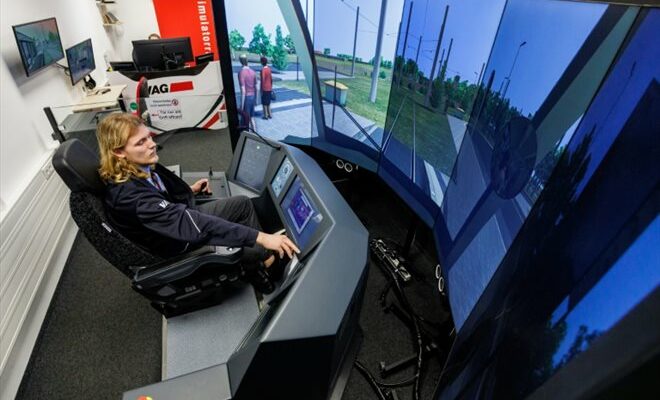Benedikt Hanne, a 24-year-old student, trains to drive a tram in Nuremberg, Germany (AFP/Daniel Karmann)
Morning on the rails, afternoon in the lecture hall: Benedikt Hanne will drive trams in the streets of Nuremberg to supplement his student income and help compensate for the lack of drivers in Germany.
Concentrated on his dashboard, the 24-year-old is already handling the red and white machine with ease, under the watchful eye of his trainer.
This world is very far from his daily life as a student studying to become a social worker.
“It’s a great feeling to have all these wagons behind you,” confides the boy with blue eyes and shoulder-length hair, as if taken back to childhood dreams on the rails of the training center of the transport company of Nuremberg (VAG).
This municipal authority must, each year, recruit 160 new drivers – metro, tram and bus combined, while the transport sector, like many professional sectors in Germany, suffers from a serious labor shortage.
– Unfilled positions –

Benedikt Hanne, a student in Nuremberg, Germany, trains to drive a tram in a simulator from the VAG transport authority (AFP/Daniel Karmann)
“We will only achieve the goal if we exploit all the possibilities that exist,” says Harald Ruben, director of recruitment and training at the VAG.
The agency therefore published job offers targeting students, offering part-time positions compatible with university schedules.
Nuremberg, in southern Germany, is not the only city to use these atypical profiles. In Munich, the Bavarian capital, the local transport authority is touting a “cool” student job that it even comes with a free subscription to travel around the city. In Mannheim, in the west of the country, a partnership called “Drive and Study” was established with the local university of applied sciences.
Due to recruitment problems, several cities are forced to occasionally reduce the frequency of local transport in circulation.
A shortage of workers has led public transport workers across Germany to go on strike in recent weeks to highlight the deterioration of their working conditions.
Many local transport operators report 20 to 30% unfilled positions, according to the Verdi transport union.
– “Cool” –
In Nuremberg, student drivers wear the red and blue uniform of the transporter. They must be at least 21 years old and have a driving license.
They follow an accelerated four-week training course during their university vacations. “Normal” training lasts almost twice as long.
On the menu every day, several hours of theory, exercises on board a simulator then a real tram. All complemented by “homework” at home.
Out of 36 applications received, the VAG recruited five students, including Benedikt Hanne, who had never imagined himself in the shoes of a tram driver.
After passing a driving test and a few days on the rails accompanied by a trainer, he will find himself alone at the controls of the machine, twenty hours a week, paid at the industry rate.
Going from the classrooms to the cockpit in the same day does not scare him.
“To choose, I would prefer to drive the tram before going to university, so that my day ends with classes,” says the man who previously held numerous student jobs, such as a salesman in a gas station. “But I also want to drive at other times of the day, to see different people and situations.”
He can’t wait to crisscross the city in “his” tram. “My classmates think it’s really cool, my family does too. They’ll get on my tram, that’s for sure.”
© 2024 AFP
Did you like this article ? Share it with your friends using the buttons below.




